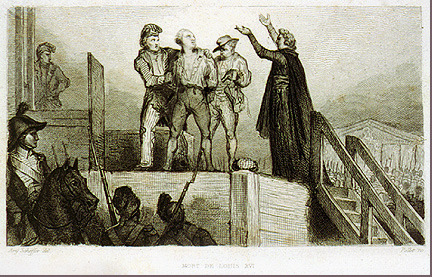A Positive View?

Annotation
This composition of the scene, in which a helpless Louis seems to be looking upward to heaven with his confessor, communicates humility. The executioners are relatively passive, leaving the King and confessor center stage. This reveals that in mortal death, the King had a chance to look better than his tormentors. Although this print was undoubtedly produced significantly after the fact, contemporary spectators also might have felt this moment of moral superiority available to the victim. As sentimentality became more prevalent in the eighteenth century, sympathy for the accused on the scaffold had grown, so that authorities had increasingly taken executions out of the public eye. Perhaps, it is likely that Louis at least realized a measure of this same concern. And possibly Sanson’s exuberance after the execution when he eagerly held aloft the King’s head, as well as a prior decision to call for a drum roll to drown out the King’s attempts to address the crowd, were meant to erase any empathy for his condition.